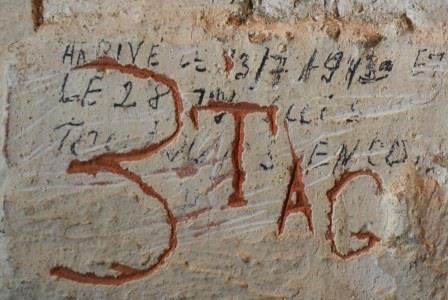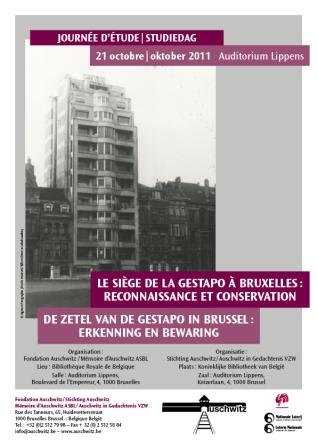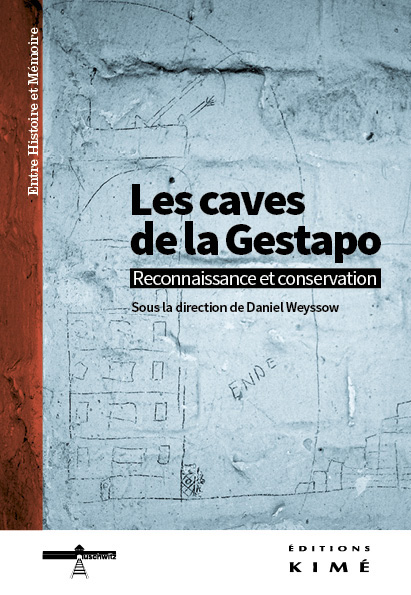The Brussels Gestapo Headquarters
 Final classification of the Gestapo cellars
Final classification of the Gestapo cellars
One will recall the decision taken by the Minister-President of the Brussels-Capital Region, Rudi Vervoort, endorsed by the government of Brussels on 9 January 2014, to begin the process of registering the cellars of the buildings occupied by the Gestapo, during the Second World War, at 347 and 453 Avenue Louise in Brussels, as historical sites.
One of the effects of the provisional classification was to oblige each owner to open his cellar to the experts of the Monuments and Sites Department. A survey of the number of cellars with traces was carried out for both buildings. The report of the Royal Commission for Monuments and Sites that followed, confirming the interest of ensuring the conservation of the site, led to the definitive classification of the cellars of both buildings on 14 January 2016.
We can, of course, only rejoice at this very happy conclusion and continue our work of investigation, advice and preservation of places of memory.
Study day on 21 October 2011
 The subject of the study day organized on 21 October 2011 by Remembrance of Auschwitz and the Auschwitz Foundation at the Royal Library of Belgium, Brussels was ‘The Brussels Gestapo Headquarters – Recognition and Conservation’ and the possibility of having the building’s cellars classified as a national monument.
The subject of the study day organized on 21 October 2011 by Remembrance of Auschwitz and the Auschwitz Foundation at the Royal Library of Belgium, Brussels was ‘The Brussels Gestapo Headquarters – Recognition and Conservation’ and the possibility of having the building’s cellars classified as a national monument.
During the Second World War, the German security services (the Sicherheitspolizei and Sicherheitsdienst, i.e. the Gestapo), requisitioned three buildings situated at 453, 347 and 510 Avenue Louise in Brussels. Nothing about these buildings now attracts the attention of passers-by, except for the memorial dedicated to Jean de Sélys Longchamps and a plaque on the facade of 453 Avenue Louise. (On 20 January 1943, Jean de Sélys Longchamps, a Belgian aviator who had joined the British RAF, machine-gunned the Gestapo buildings from the air, severely damaging them).
Yet they are among Belgium’s most important and most symbolic Second World War sites of evil memory, as they were the premises of those who carried out the arrests of so many resistance fighters and organized the deportation of the Jews of Belgium and the north of France. Indeed, many survivors have given testimony on the interrogations and tortures which took place in them.
The morning session dealt with the history of the Brussels Gestapo headquarters and some of its branches and offshoots in Belgium and northern France. The afternoon will be devoted to the possibilities for conserving the inscriptions carved on the cellar walls by the Nazis’ victims.
Publication of the proceedings of the conference

Daniel Weyssow (ed.), Les caves de la Gestapo. Reconnaissance et conservation , Paris, Kimé,‘Entre Histoire et Mémoire’, no. 6, 2013, 213 p. (€20.00) : Proceedings of the study day on 21 October 2011)
Building numbers 453, 347 and 510 of one of the most beautiful streets of Brussels, Avenue Louise, were requisitioned during the Second World War by the Gestapo. They became true torture centres, the walls of their cellars are still covered with inscriptions and drawings depicting the despair and the last will of the prisoners. However, until now, none of these buildings have received any recognition. This collection is composed of contributions from specialists as well as survivors and have two vocations:
- Raise awareness among government officials and politicians that this forgotten memory must finally be recognized.
- Give the readers a thorough study of scientific significance of these places and of other similar sites (Breendonk, Cologne, Krakow, Fresnes, and Romainville).
Supplements to the published volume:
- Original text: Grégory Célerse (Local historian and researcher at the Museum of Resistance of Bondues), Le siège de la Gestapo de La Madeleine (Lille) (PDF in French) [The Gestapo headquarters of La Madeleine (Lille)]
- Benoît Majerus, “La Sipo-SD en Belgique. Une police faible ?”, Vingtième Siècle. Revue d'histoire, no. 119, 2013/3, p. 43-54. [The Sipo-SD in Belgium. A weak police?] (click in the table at the bottom of the page on the link to the PDF file)
- The preservation of the cellars of Avenue Louise in question: Daniel Weyssow, La journée d'étude en débats. Table ronde et interpellations parlementaires (PDF in French) [The conference in discussions. Roundtable and parliamentary questions]
Additional photographs to those presented in the following contributions of the volume:
- Daniel Weyssow, Une évocation par les témoignages du siège de la Gestapo à Bruxelles (Galerie) [An evocation by the testimonies of the Gestapo headquarters in Brussels] (Gallery with the captions in English)
- Daniel Weyssow, Découverte de la cave n° 16 du 453 avenue Louise (7 galeries) [Discovery of cave no. 16 of 453 Avenue Louise] (7 galleries with the captions in English) – Légendes complètes des photos des 7 galeries (PDF in French) [Full captions of the photos of the 7 galleries]
- Karola Fings, D’une cave d’archives vers un lieu de mémoire d’importance européenne. Les inscriptions murales de la EL-DE Haus et le lieu de mémoire « Prison de la Gestapo » (Galerie) [From a cellar full of archives to a memorial of European importance. The wall inscriptions of the EL-DE Haus and the place of remembrance “Gestapo Prison”] (Gallery with the captions in English)
- Albert Bouckaert, Après « leur » départ. Dans le repaire de la Gestapo (Galerie avec fac-similé des pages 6 et 7 du Soir illustré du 27 septembre 1944, n° 641 et l'ensemble des photos) [After “their” departure. In the hideout of the “Gestapo”] (Gallery with facsimile of pages 6 and 7 of the Soir illustré no. 641 of September 27, 1944, and all of the photos with the captions in English)
- Olivier van der Wilt, Les détenus de la Sipo-SD en Belgique : des caves de l’avenue Louise aux cellules de Breendonk (PDF) (PDF in French and Dutch) [The Prisoners of the Sipo-SD in Belgium: from the cellars of Avenue Louise to the cells of Breendonk]
Contact
Auschwitz Foundation – Remembrance of Auschwitz
Rue aux Laines 17 box 50 – B-1000 Brussels +32 (0)2 512 79 98
+32 (0)2 512 79 98 info@auschwitz.be
info@auschwitz.be
BCE/KBO Auschwitz Foundation: 0876787354
BCE/KBO Remembrance of Auschwitz: 0420667323
Office open from Monday to Friday 9:30am to 4:30pm.
Visit only by appointment.
![]()
![]()
![]()
![]()
![]()
Become a member
To become a member of Remembrance of Auschwitz ASBL, please contact us and transfer the sum of €50.00 to our account IBAN: BE55 3100 7805 1744 – BIC: BBRUBEBB with the communication: ‘Membership fee 2025’. The membership includes two issues of 2025 of our scientific journal.
DONATIONS
Donations of €40.00 or more (in one or more instalments) qualify for tax exemption for Belgian taxpayers.
In communication, please specify that it is a ‘Donation’ and mention your National Number which is required since 2024 to benefit from the tax exemption.
Subscribe
Error : Please select some lists in your AcyMailing module configuration for the field "Automatically subscribe to" and make sure the selected lists are enabled














